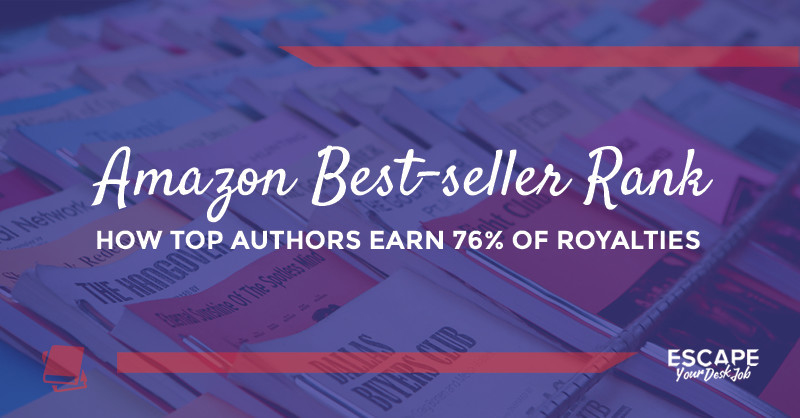This past week, as required by Amazon, I had to determine two categories for my latest book, “Quora Domination: How Top Writers Get 1,000,000 Views and Featured in Forbes” and decided to really dig in and figure out how the Amazon Best-Seller Rank works.
Here’s what I found…
Getting to Know Amazon Best-Seller Rank
First off, we need to understand what exactly is the Amazon Best-Seller Rank. Knowing how it works will allow us to figure out what category selection is optimal for our book.
On the surface, it’s really simple.
Each book across the entire Kindle store is given a rank upwards from one.
If you go to the sales page for your book, under “Product Details” you’ll see it:
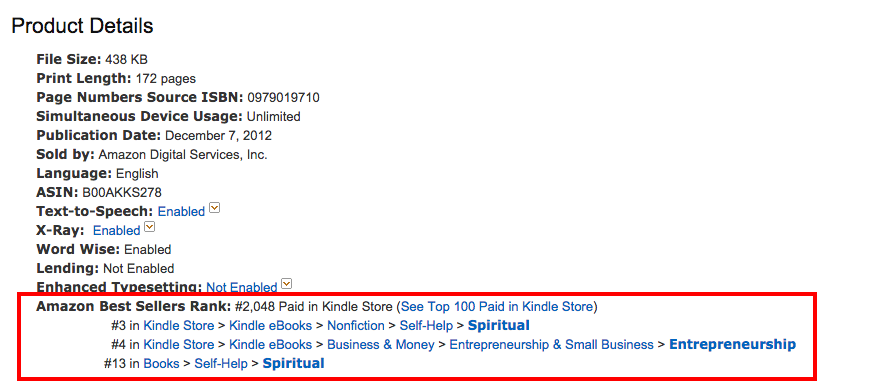
This rank (both free and paid) is based PURELY on unit sales, and has nothing to do with reviews and ratings.
That being said, having more reviews DOES impact the perception of your book and can lead to extra sales which in turn leads to your book moving up the rank.
Moreover, the Amazon Best-Seller Rank is not representative of cumulative sales volume but strictly the most recent sales.
According to Amazon, the Amazon Best-seller Rank is re-calculated hourly.
Another article on WebProNews, claims that only the top 10,000 books are re-calculated hourly while books ranked 10,000+ are only re-calculated on a daily basis.
Point is this…
The Top 10% of Books Make Disproportionately More Sales
Next, you should understand that book sales on Amazon take a logarithmic distribution meaning the top few books account for a disproportionate amount of sales.
How disproportionate exactly?
The top 20% of authors are making 16 times as much as the bottom 80% of authors. That is, the top 20% of authors earn 76% of all royalties.
In terms of daily sales this means:
- The top 1% of books get 31% of daily sales
- The next 9%, 28% of daily sales
- The next 10%, 15% of daily sales and
- The final 80% of books make up the final 26% of sales.
And in terms of copies sold per day:
- Top 1% of books average 2,000 copies per day
- Next 9% average 200 copies per day
- Bottom 90% average 30 copies per day
OR to make it even more clear…
- 67 sales for the top 1% to every
- 6.7 sales for the next 9% to every
- 1 sale for the bottom 90%
Here’s what I take away from these stats…
It’s unlikely you will break into the top 1% of books, maybe not even into the top 10%.
How Best-Sellers Lists REALLY Work
When someone claims that they are an Amazon Best-Seller, don’t be fooled.
The truth of the matter is that there are hundreds of best-sellers lists on Amazon. There is one for all Kindle eBooks and there is even one for something as small as Dollhouses.
Obviously, it doesn’t take much to be a best-seller in Dollhouses!
Here’s where we start talk about selecting a category…
…because each best-seller list corresponds to one category that you can choose.
Now, there is a balance to choosing the correct category.
Choose one that is super profitable and chances are there will be a ton of competition. This will make it harder to rank on the first page meaning less sales for your book.
Here’s one: Business & Investing
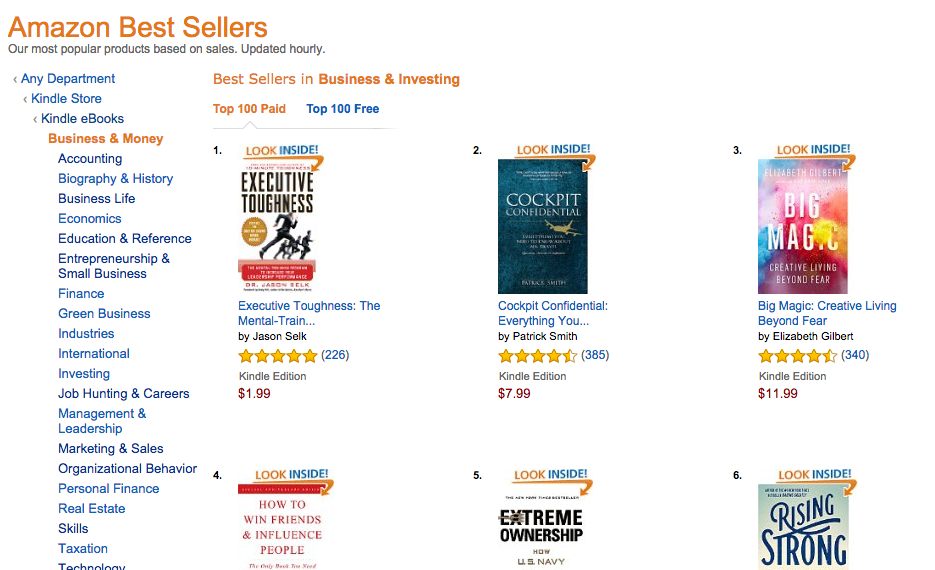
Choose one that is easy to compete in and chances are it is not very profitable. You may be able to rank on the first page but what will it matter if no one is looking at that category.
Here’s one: Natural Law Perspectives
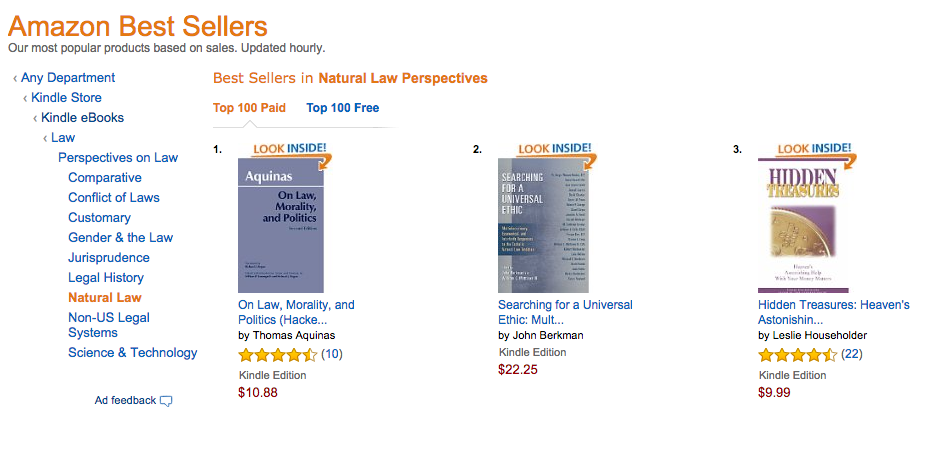
The Awesome Tool I Use
What we know so far is that we want to rank on the first page for a best-seller list and to stay there we need to sell more books per hour than the 20th rank book.
Cool.
You could go about checking the rank of the 20th book on each best-sellers list and then use the table below to see how many books they are selling to know where you’ll stand.
| Amazon Best-Seller Rank | Daily Book Sales |
|---|---|
| 1 to 5 | 4,000+ |
| 5 to 20 | 3,000 – 4,000 |
| 20 to 35 | 2,000 – 3,000 |
| 35 to 200 | 500 – 2,000 |
| 200 to 350 | 250 – 350 |
| 350 to 500 | 175 – 250 |
| 500 to 750 | 120 – 175 |
| 750 to 1,500 | 100 – 120 |
| 1,500 to 3,000 | 70 – 100 |
| 3,000 to 5,500 | 25 – 70 |
| 5,500 to 10,000 | 15 – 25 |
| 10,000 to 50,000 | 5 – 15 |
| 50,000 to 100,000 | 1 |
Or you can do like I do and buy this chrome plug-in: Kindle Spy.
Here’s how it works.
How Kindle Spy Works
Let’s run through two example categories I was looking at.
First, we’ll look at “Marketing & Sales → Marketing”.
I start by visiting the link above and then clicking the Kindle Spy plugin in my chrome browser.
This brings up the screen below.
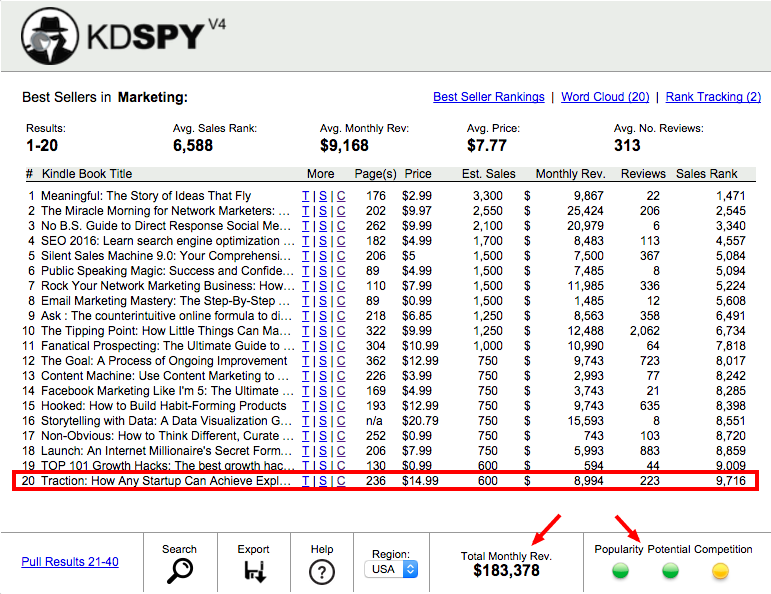
In spot 20, you’ll notice the book Traction is there doing about 20 sales per day (600/30) and having a rank above 10,000.
Moreover, Kindle Spy gives you the monthly revenue for the best-seller list along with how popular and competitive the category is and how much potential it has for sales.
In my opinion, this would be a BAD category to go after because as an author without a following, you’ll have a tough time getting 20 sales per day.
This took me 30 seconds to realize this as compared to the cumbersome manual process you would have to go through otherwise.
This tool is amazing.
Let’s try another one.
This time we’ll try “Marketing & Sales → Marketing → Direct Marketing”
Noticed how I simply dropped down one level and went more niche to see if I could rank. You can do this or choose an entirely different category, it’s up to you.
Here are the results from Kindle Spy:
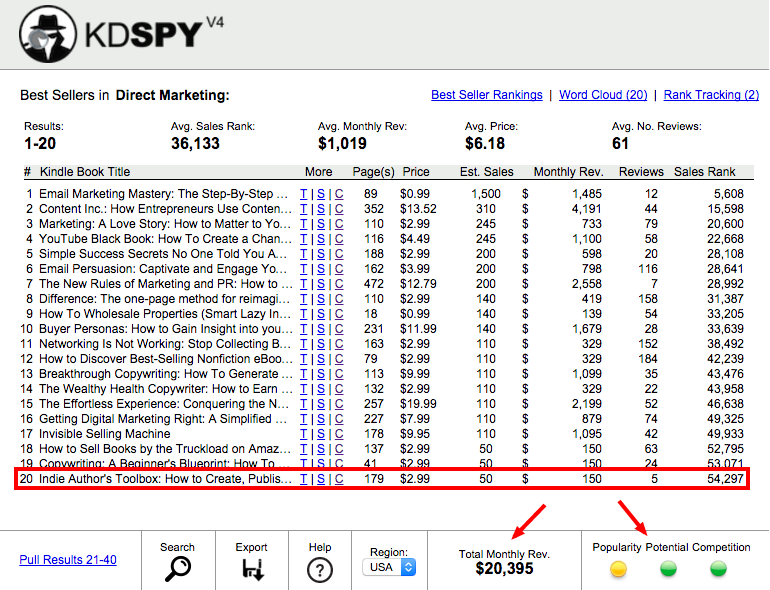
This time, the 20th ranked book is only doing 5 sales per day and is sitting at around 50,000 for its Amazon Kindle Best-Seller rank.
Also, notice that the monthly revenue is way down from the previous category we looked at. That’s just the name of the game – the less competitive, the less money you can make.
This is a MUCH better category to select because I’d rather stand out than be buried deep in the rankings.
I kept doing this for multiple best-sellers list and eventually settled on two that had the perfect balance of competition to revenue potential.
So from there, I knew I had two categories that would work for my book.
There usually isn’t a way to enter these categories through the KDP dashboard so you’ll have to contact support yourself and let them know you want your book listed in your chosen categories.
Visit this link, click the “Contact Us” button on the bottom left and follow the instructions to message them to let them know about your new category request.
The Predictive Model Curve Ball
Even though recent sales are the major ranking factor, Amazon does have their own predictive features built into the Amazon Best-Seller Rank, which are likely based on historical data of a product.
So for instance, if a new book is selling well, it will move up past a book that has been on the store for 3 years even though the older book may have more cumulative sales.
Amazon can see that eventually the new book will overtake the older book in time.
This also means that if your book is way down in the rankings at 750,000 and you sell a few books, it can quickly jump to the 100,000th spot.
But as you sell more books, if becomes harder and harder to break into the next tier – 10,000th, 5,000th, etc. because Amazon predicts your sales will eventually fall off.
Wrapping Up
Here’s what this all means when it comes to selecting categories…
Having one big launch is not as important as having consistent sales over time.
This means you’ll want to do some of your own promotions to keep your book selling and then letting Amazon pick it up and keep it high in the rankings getting you organic sales.
Moreover, you will want your books page to be converting into sales at a high rate with a good description, title, benefit statements and the works – but you already knew that.
Finally, make sure to choose the Amazon Best-Seller Rank categories that give you the greatest chance of staying ranked within the top 20 books on the list.

